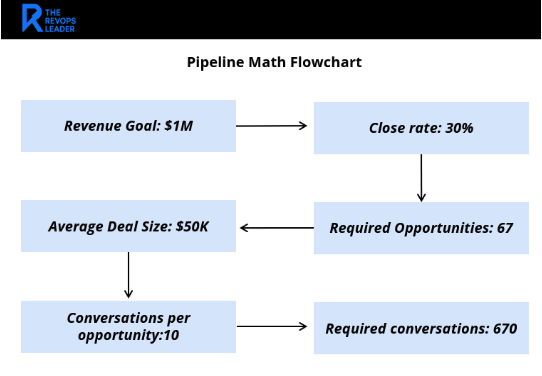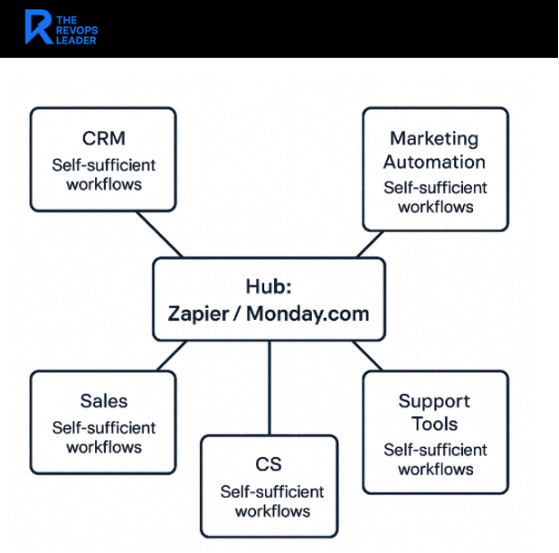Dominate One Channel. Automate the Rest. The New GTM Math
Stop spreading your GTM team thin. Master one channel, automate the grunt work, and watch pipeline multiply.
Every week, we listen to dozens of ReVOps podcasts and extract the top actionable ideas. (For more context on these ideas, give the podcasts a listen)
In this issue:
Build a Million-Dollar pipeline by dominating ONE channel and owning relationships
Stop treating RevOps like overhead… it’s your company’s secret weapon for growth!
Great RevOps is about empathetic change management
1. Build a Million-Dollar pipeline by dominating ONE channel and owning relationships
AI GTM WTF podcast by Nevara, Episode: How to Build a $1M Pipeline from Zero (Oct. 16, 2025)
TLDR:
Pipeline success starts with mastering the fundamentals: clean data, crisp messaging, and clear metrics before scaling
Pick ONE outreach channel and dominate it completely before expanding
Automate everything EXCEPT relationship-building.
Nilan Chaudhury has built hundreds of millions in pipeline at companies from scrappy startups to unicorns. His approach cuts through the AI hype and gets back to fundamentals.
Most companies think they have a lead problem when they actually have a data and systems problem. Before you chase new channels or fancy tools, nail down three things: your ideal customer profile, your messaging, and your metrics.
The four W's of pipeline qualification
You need clarity on the who (decision maker), the what (their problem), the when (timeline), and the why (urgency). If you can't answer at least three of these four questions clearly, it's not real pipeline – it's just a name in your CRM.
For example, a prospect might respond to an email about improving their sales process. But if you don't know who makes the buying decision, when their budget cycle happens, or why this matters now versus next quarter, you're building false confidence. Real pipeline means you understand the path to close.
Start with the math, then build the path
Most people work backwards. They set revenue goals without understanding the mechanics. Chaudhury flips this: sit down with your CEO, first AE, or GTM team and reverse engineer the numbers. If you need $1 million in new revenue and your average deal is $50,000 with a 30% close rate, you need 67 qualified opportunities. If it takes 100 conversations to generate 10 opportunities, you need 670 conversations. Now you have your activity targets.
This math shows you whether your goals are realistic, where your bottlenecks are, and what levers you can pull. Maybe your close rate is the problem, not your top-of-funnel. Maybe you need to increase deal size, not volume. The numbers tell the story.
Channel mastery beats channel variety
Here's where most teams waste resources: they spread thin across email, LinkedIn, phone, and events before dominating any single channel.
Chaudhury's advice is ruthlessly focused: pick ONE channel and become exceptional at it before expanding. If that's cold calling, understand your connect rate, connect-to-conversation rate, and conversation-to-meeting rate inside out.
This focused approach compounds learning faster than trying everything at once.
Automate the grunt work, own the relationships
AI should handle data enrichment, list building, and basic research. What it can't replace is the human element of understanding pain points, building trust, and navigating complex buying decisions.
Chaudhury's rule:
Automate everything that doesn't build relationships. Let AI find prospects, enrich data, and even draft initial outreach. But when it comes to discovery calls, qualifying conversations, and closing deals, that's where humans shine.
The Bottom Line
Building a million-dollar pipeline isn't about the latest growth hack or AI tool. It's about getting laser-focused on your ICP, picking one channel and dominating it, and automating everything that doesn't build relationships. Master the fundamentals, then technology amplifies what already works.
2. Stop treating RevOps like overhead… it’s your company’s secret weapon for growth!
DisrupTV podcast by Constellation Research (“Research to empower enterprise adoption”), Ep. 415: Fix Your Blindspots. Unleash RevOps. Scale Smarter. (Oct. 17, 2025)
TLDR:
RevOps is your company's "pit crew": the driver gets glory, but the pit crew determines if you win or lose
Companies with dedicated RevOps functions grow 30% faster and are more resilient than those without
Get organizational alignment and data transparency right first, then AI and automation become force multipliers
Amy Osmond Cook, co-founder and CMO @ Fullcast and Ryan Westwood, CEO @ Fullcast, recently published "The RevOps Advantage" (on Amazon) and their core message challenges how most companies think about revenue operations. They argue RevOps isn't a support function – it's strategic leadership that makes or breaks your growth trajectory.
The analogy they use: just as a Formula 1 driver can't win without an elite pit crew, your sales team can't hit numbers without RevOps orchestrating everything behind the scenes.
The 30% advantage is real
Here's the data: companies with a dedicated RevOps function grow 30% faster than those without. They're also more resilient when markets shift. Why? Because RevOps breaks down the silos between sales, marketing, and customer success. Instead of three teams optimizing for their own metrics, you have one function ensuring everyone moves toward the same revenue goals.
For example, marketing might generate tons of leads that sales calls "unqualified." Sales blames marketing for wasting their time, marketing blames sales for not following up.
RevOps sits above that conflict and asks: What does a qualified lead actually look like? How do we define it? What data proves it? Then they build systems and processes that align everyone to that shared definition.
Alignment before automation
Too many companies miss this critical point: technology doesn't fix broken processes; it just automates the mess faster.
Before you deploy AI agents or sophisticated automation, you need two things in place: organizational alignment and data transparency.
Alignment means everyone understands the strategy and their role in it. If sales and marketing operate in separate silos with different goals, adding AI just amplifies the dysfunction.
Transparency means leadership actually looks at data and makes decisions based on it, not gut feel or politics.
Once you have those human elements working, technology becomes transformative. AI can automate repetitive work, surface insights faster, and help teams make better decisions.
RevOps enables technology adoption
When companies struggle with new tools, it's rarely the technology's fault. It's usually a people and process problem. RevOps is uniquely positioned to solve this because they understand the entire revenue engine. They know where handoffs break, where data gets messy, and where friction slows deals.
For instance, if your CRM is a mess, it's not because Salesforce is bad. It's probably because nobody defined clear data standards, enforced them, or trained people properly.
RevOps fixes that by creating governance, building scalable processes, and ensuring that teams actually use the tools correctly.
Strategic positioning matters
Too many companies still treat RevOps as tactical support: someone to fix reports or manage the CRM. Cook and Westwood argue this is a massive missed opportunity. When RevOps has a strategic leadership role with visibility into every part of the revenue engine, they can spot problems early, optimize across functions, and drive meaningful improvements.
Think about forecasting:
Sales gives you their forecast, which is often optimistic.
Marketing gives you their pipeline projections, which might not match sales definitions.
Customer success has renewal data that no one connects to acquisition costs.
RevOps brings all this together, spots the gaps, and gives leadership an accurate picture of where revenue really stands.
The Bottom Line
Stop treating RevOps like overhead. It's the function that makes your revenue engine work as an integrated system instead of disconnected parts. Companies that recognize this and give RevOps strategic authority grow 30% faster because they eliminate the inefficiencies, misalignments, and data chaos that hold everyone else back.
3. Great RevOps is about empathetic change management
RevOps Impact podcast, Episode: The RevOps Review w/ James Kase (Oct. 18, 2025)
TLDR:
RevOps leaders who've done sales understand what actually helps versus what adds busywork
Manage change carefully by providing steady updates rather than bombarding teams with 10 different changes at once
Build AI agents systematically and track everything in a centralized project management system
James Kase, Associate Director of RevOps at Healthie, took an unconventional path to RevOps. He started in customer service, moved to sales, and discovered his sweet spot was making systems work better for the people using them.
Empathy makes better operations
Most sales reps don't wake up thinking "I hope operations changes five things in Salesforce today." They're running at 100 miles an hour trying to hit quota. Kase learned this firsthand doing the job himself, which fundamentally changed how he prioritizes work.
For example, when considering a new field requirement in the CRM, he thinks through the sales rep's perspective. If they're in the middle of a great discovery call and have to stop to fill out three new mandatory fields, that kills momentum. Better to capture that data through automation or integrate it differently.
He asks: Does this actually help reps close deals, or does it just give operations better visibility? The best ops teams optimize for the user's workflow, not for perfect data.
Change management is your superpower
Here's what Kase sees constantly: operations teams build something amazing, roll it out with minimal communication, and then wonder why adoption is terrible.
When rolling out AI agents across Healthie, he doesn't just announce it in Slack. He schedules dedicated review calls, documents everything in Monday.com where stakeholders can provide feedback, and makes sure no change comes out of left field. Think of it as “steady flow” rather than tsunami.
The AI agent rollout framework
Kase is currently leading Healthie's biggest AI initiative: building agents for the entire company, starting with GTM functions. His approach is methodical. He uses Monday.com to track every AI request, categorizing them by priority (P1 through P6), current status, and business impact.
For each agent, he asks:
What business problem does this solve?
Does it actually need AI, or could we solve it another way?
How do we measure success?
This prevents "AI for the sake of AI" projects. For example, agents that automatically create notes after sales calls, summarize customer interactions, or draft follow-up emails all pass this test – they take thankless, repetitive work off people's plates so they can focus on higher-value activities.
Integration is where RevOps shines
One often-overlooked skill for RevOps professionals is integration work. Kase uses Zapier extensively to connect different systems without needing engineering resources.
Learning to use integration platforms well is incredibly high-leverage. He recommends starting with Zapier's support team, especially on paid plans where you get dedicated help to follow best practices.
The goal is making teams self-sufficient. If you can build workflows that don't break and don't require constant ops intervention, you've succeeded.
The Bottom Line
Great RevOps isn't about implementing every new tool – it's about having a clear plan for what problem you're solving, managing change thoughtfully so teams actually adopt it, and building scalable systems that work without constant babysitting. As Kase puts it, "I'm usually trying to work my way out of a job" by making each department self-sufficient.
Disclaimer
The RevOps Leader summarizes and comments on publicly available podcasts for educational and informational purposes only. It is not legal, financial, or investment advice; please consult qualified professionals before acting. We attribute brands and podcast titles only to identify the source; such nominative use is consistent with trademark fair-use principles. Limited quotations and references are used for commentary and news reporting under U.S. fair-use doctrine.


